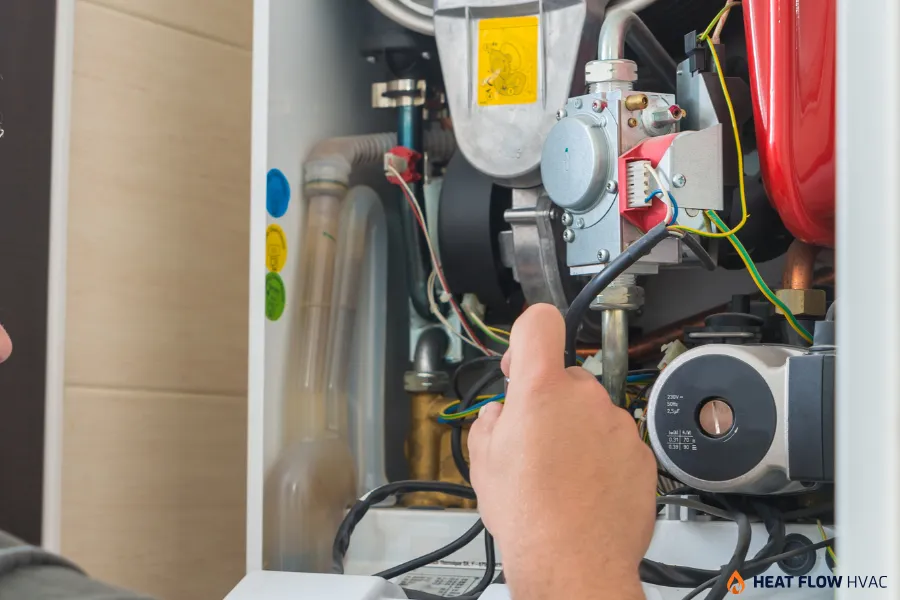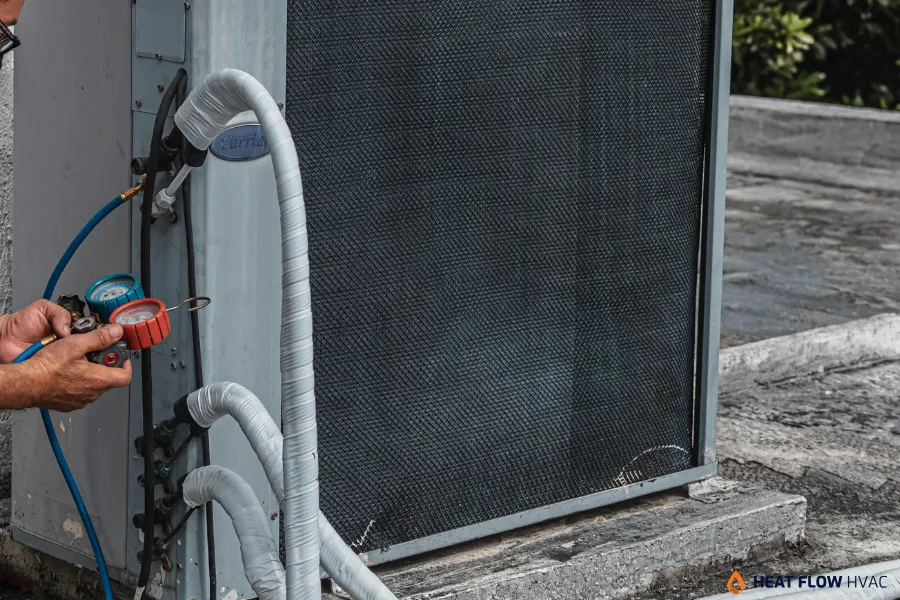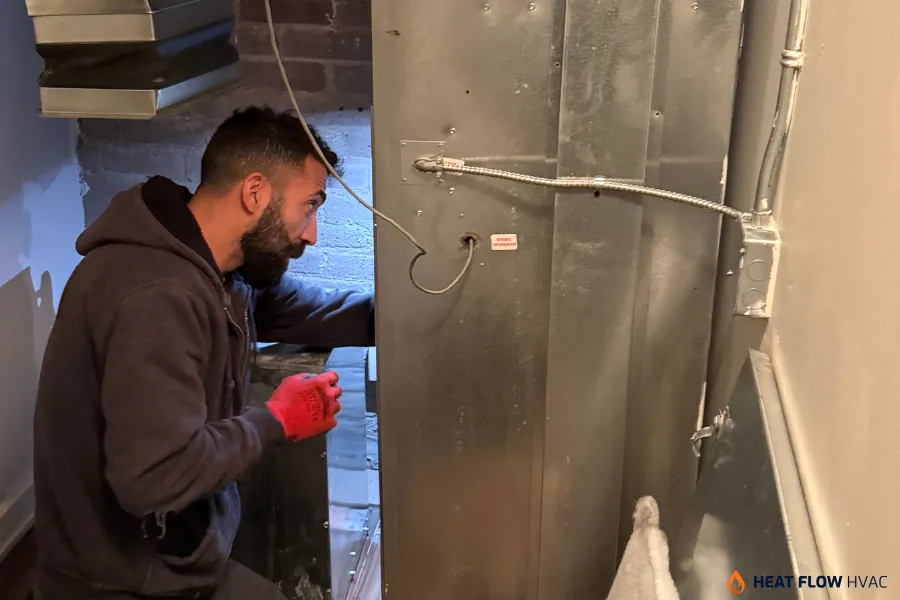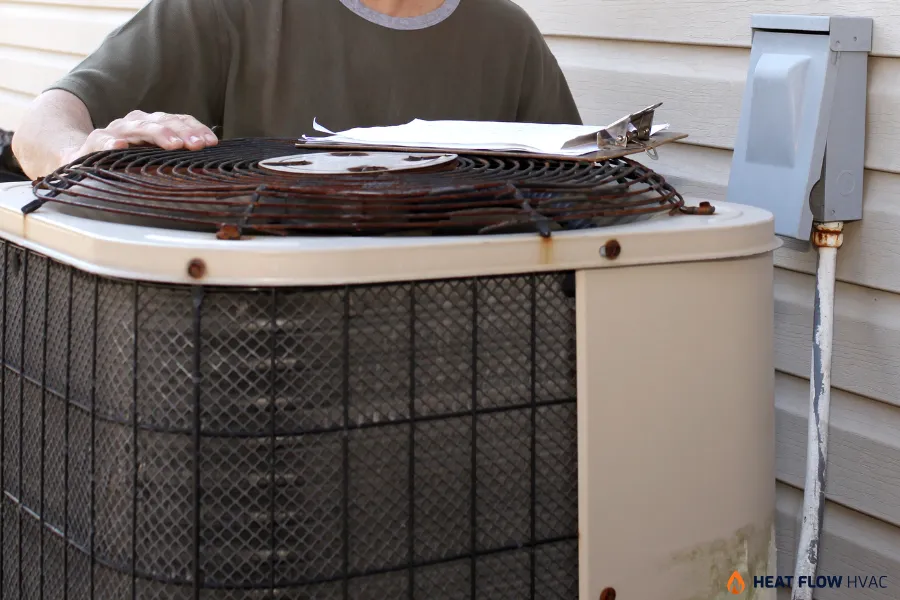If you’ve ever walked from one room in your building to another and felt a sudden shift from chilly to stuffy, you’re not alone. Hot and cold spots are one of the most common and frustrating complaints we hear from homeowners and business owners alike. Uneven temperatures make it hard to stay comfortable, strain your HVAC system, and usually signal that something behind the scenes isn’t working right. At Heat Flow HVAC, we’ve helped customers across neighborhoods, offices, shops, and homes solve this exact issue with smart, proactive steps. In this guide, we’ll explain what causes temperature inconsistencies, how they affect your comfort and your wallet, and what you can do to fix them before they turn into costly AC repairs or furnace breakdowns.
If you’re constantly adjusting your thermostat or receiving complaints from employees or tenants about uncomfortable rooms, it’s time to take a closer look at your system. Whether you’re dealing with old ductwork, poor insulation, or a misbehaving AC needing a repair, there’s always a reason behind uneven heating and cooling, and always a solution when you know where to look.
What Causes Hot and Cold Spots in Buildings
A building should heat and cool evenly. When it doesn’t, it’s usually a sign that something in your HVAC system isn’t balanced. It could be airflow issues, blocked vents, duct leaks, or even something as simple as a dirty filter. But what starts as a slight temperature difference can grow into a larger problem. Energy bills go up. HVAC units work harder and wear out faster. Customers feel uncomfortable. Employees get distracted. And in extreme weather, certain rooms become nearly unusable.
Here’s what hot and cold spots mean for your building:
- Your system may be running longer than necessary, costing you more every month
- Certain rooms may be getting too much airflow, while others are starving for it
- You might be unknowingly overloading parts of your system, leading to breakdowns
- Drafts or insulation gaps may be letting conditioned air escape
- Your duct design or layout might be working against you
Fixing this isn’t just about comfort. It’s about long-term performance, energy savings, and avoiding expensive air conditioner repair or furnace service calls when things spiral out of control.
Common Causes of Temperature Imbalance
Temperature differences in a home or commercial space can come from a variety of sources. It takes more than guesswork to pinpoint what’s wrong. Below are the most frequent culprits we come across during inspections and service calls.
Poor Air Circulation
Without proper air movement, rooms closest to the HVAC system may be freezing while others barely cool off. Poorly placed supply and return vents, furniture blocking airflow, or dirty fans can all prevent even circulation.
Dirty Filters
One of the simplest causes with the biggest impact. Clogged filters restrict airflow and reduce the system’s ability to push air through the ducts evenly. Rooms at the end of duct runs are especially affected.
Incorrect Thermostat Placement
Thermostats should be in neutral, central locations. If your thermostat is in direct sunlight, near a draft, or right next to a vent, it can misread the temperature and tell your system to turn off too soon or run longer than necessary.

Leaky or Poorly Insulated Ducts
Old, unsealed ducts leak conditioned air into crawlspaces, attics, or walls. That means less air makes it to the rooms that need it. Inconsistent duct sizing or long duct runs can also result in temperature differences between rooms.
Inadequate Insulation
Some rooms may have poor wall or attic insulation, especially if they were added later or sit above garages. These spaces gain or lose heat more quickly than well-insulated areas, making it harder for your HVAC system to keep up.
Wrong HVAC Sizing
An oversized or undersized HVAC unit can’t maintain consistent temperature control. Too big, and it short cycles without properly dehumidifying. Too small, and it struggles to condition every room.
Closed or Blocked Vents
It might seem like a good idea to close vents in unused rooms, but doing so can disrupt system pressure and airflow, making other areas of the building uncomfortable.
Zoned HVAC System Malfunctions
If your system is set up with zoning and one zone malfunctions, it can create uneven temperatures throughout the building. Thermostats, zone dampers, or controllers may be the problem.
Signs That Your Building Has Airflow Issues
If you’re not sure whether the discomfort you’re experiencing is airflow-related, here are some tell-tale signs to look for:
- You’re constantly adjusting the thermostat
- One floor is always warmer or colder than the rest
- Rooms near windows feel drastically different than interior spaces
- Some vents are blowing too hard while others barely have airflow
- The furnace or AC seems to run constantly without maintaining comfort
If any of this sounds familiar, it’s time to have a professional take a look. Consistent airflow is one of the biggest indicators of a healthy HVAC system.

How Hot and Cold Spots Affect Energy Use
Aside from comfort issues, temperature imbalances in your building can drastically affect your energy use. When your system has to work harder to condition uneven spaces, it leads to:
- Increased monthly energy costs
- Frequent cycling that shortens system lifespan
- Risk of overheating or freezing sensitive components
- Over-reliance on backup heating or cooling devices
Whether you’re running a small office or managing a multi-tenant building, hot and cold spots waste energy and money. This is where proactive checkups make all the difference. Regular HVAC maintenance helps detect airflow problems early, before they turn into full-scale air conditioner repair or furnace service calls.
Solutions For Hot and Cold Spots In Buildings
The good news is that hot and cold spots are fixable, and you don’t always need a full system overhaul to fix them. Here are solutions that have worked for our clients across residential and commercial spaces:
Schedule Air Balancing
We can redefine your ducts, dampers, and registers to rebalance airflow where needed. This treatment is a grand impact without requiring equipment replacement.
Upgrade or Seal Ductwork
Faulty or older ducts may be sealed, patched, or re-routed to prevent loss of air. Duct upgrades sometimes also firm up room temperatures.
Install a Zoned HVAC System
For larger homes or multi-purpose business structures, a zoning system enables you to regulate individual zones. This avoids overcooling or overwarming sections of the building that don’t need it.
Regular AC and Furnace System Maintenance
Routine service keeps all running in peak condition. We clean coils, check fan function, test thermostats, and change filters to prevent skewed heating or cooling before it starts.

Consider Ductless Options for Add-On Spaces
If your hot or cold spot is in an addition or converted garage, ductwork might not be an option. A ductless air conditioner offers precise control without interfering with the current system. Learn more about ductless air conditioner maintenance and installing a new unit.
Increase Building Insulation To Reduce Hot and Cold Spots In Buildings
Increasing attic insulation, weatherstripping window and door leaks, and wall insulation in some zones can considerably reduce temperature variation between rooms.
Comparing Quick Fixes vs Long-Term Solutions
Problem |
Quick Fix |
Long-Term Solution |
| Dirty filters | Replace filter | Set a filter replacement schedule |
| Cold rooms above garage | Use portable heater | Add insulation under the floor |
| Uneven airflow | Adjust registers | Air balancing + duct sealing |
| Thermostat reading wrong | Move fan mode to “on” | Relocate thermostat to neutral zone |
| One room always hot | Add window unit | Install a ductless split system |
Sometimes short-term fixes help in a pinch, but for real comfort and lower energy bills, long-term solutions backed by professional inspection are the way to go.
Prevent Hot and Cold Spots In Buildings with Regular HVAC Checkups
Waiting for something to go wrong is already suffering discomfort and added costs. The best approach is prevention. Regular HVAC maintenance gives you the chance to catch airflow issues, failed motors, refrigerant imbalances, and duct problems early in the day. It is also the best time to optimize airflow and get every part of your building as comfortable as can be.
At Heat Flow HVAC, we offer homes, retail stores, offices, and businesses of all sizes affordable and thorough inspections. Our technicians inspect everything from filters to fans, thermostats to ducts. That means fewer surprises, fewer last-minute calls, and more consistent temperatures year-round.
If your building is experiencing hot and cold spots, don’t wait until summer or winter comes in full swing. A quick tune-up today could prevent you from spending hundreds on AC repairs or furnace service later.
Ready to be cozy from end to end? Let’s repair your airflow and balance things out.
